Fix: TeamViewer Stuck on Initializing Display Parameters
Several users are reporting that their TeamViewer client is getting stuck and hangs when they attempt to connect to a device or partner. Some users report that the issue happens occasionally while others are complaining that they see the “Initiating display parameters” error at every connection attempt.

What is causing hanging during “Initiating display parameters” phase in TeamViewer?
We investigating this particular issue by looking at various user reports and the repair strategies that most affected users have successfully deployed to get to the bottom of this issue. Based on what we gathered, there are several common scenarios that will trigger this particular error message:
- TeamViewer version is outdated – One possible scenario is that the TeamViewer client version that you’re using is outdated. Versions older than TeamViewer 12 are equipped with a hotfix that resolves the glitch that was known to trigger the “Initiating display parameters”. If this scenario is applicable, updating the client to the latest version on both machines should resolve the issue.
- Remote Wallpaper is enabled – This particular TW setting is known to facilitate the apparition of this error message. Several users have reported that the connection was initiating without errors once they disabled Remove Remote Wallpaper from the Options menu.
- Display Quality is set to Optimize Quality – Several affected users have reported that the issue was resolved as soon as they changed the Display quality to Optimize Speed. This is typically reported to be effective in those cases where one of the machines is dealing with an unstable network connection.
- Unnatended Remove Access is not configured – This error might also occur if the TeamViewer client is not configured to allow connections if someone is not logged in. If this scenario is applicable, you will be able to resolve it by reinstalling TeamViewer with Unattended Remote Access.
- The PC is not configured for remote control – It’s also possible that TeamViewer doesn’t have the necessary permissions because your computer is not configured to allow remote control access. If this is applicable, you can revert this setting by taking a trip to the System Properties screen.
- A process is conflicting with TeamViewer – BGInfo (a process belonging to SysInternals) is known to trigger the “Initiating Display Parameters” hang by conflicting with the TW app. As it turns out, this occurs because both applications will request access to some settings related to the wallpaper. In this case, disabling the conflicting process should resolve the issue.
- Host PC is in standby mode – Another possible reason why this issue occurs is that the host pc is currently in standby mode with the screen turned off. This is known to produce this particular error with even the newest TW builds. In this case, adjusting the Power settings on the host PC to ensure that the screen doesn’t get turned off again should resolve the issue.
If you’re currently looking for a fix that will resolve the hanging during the “Initiating display parameters” phase, this article will provide you with several troubleshooting steps.
Down below, you’ll find a collection of methods that other users in a similar situation have sucesfully used to get the issue resolved and use TeamViewer normally.
Method 1: Update Teamviewer on both sides
Before you try anything else, it’s important to make sure that both involved machines have the same version and they are both updated to the latest build. The development team behind Teamviewer is known for pushing hotfixes when the glitch or bug is hindering the functionality of the platform, so chances are you will be able to resolve the issue just by updating the client on both the involved machines.
Here’s a quick guide on doing this:
- Open Teamviewer or cancel any active connection if the application is already opened.
- Use the ribbon bar at the top to access Help tab, then click on Check for New version.
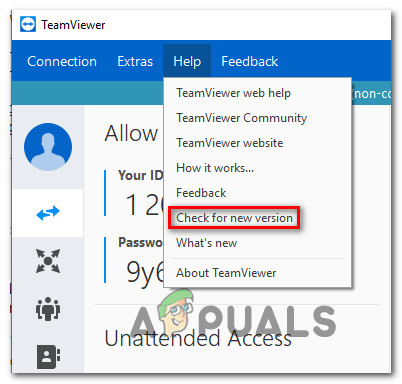
Checking for a new TeamViewer version - If a new version is found, follow the on-screen instructions to download & install the newer build.
- Repeat the process on the second machine.
- Restart both computers and see if the issue is still occurring.
If you’re still getting stuck at the “Initiating display parameters” screen when trying to establish the connection, move down to the next method below.
Method 2: Adjusting Display Quality & removing Remove Wallpaper
Several affected users have reportedly been able to work around this issue by changing some settings on the machine that they tried to connect to. By ensuring that Remove wallpaper is active and setting the Display quality to Speed, most users have reported that they were able to get past the “Initiating display parameters” screen.
Here’s a quick guide on how to do this:
- Open Teamviewer on the machine that you try to connect to.
- Using the ribbon at the top, go to to the Extras tab and click on Options.
- Inside TeamViewer options, select the Remote control tab from the left-hand-side menu. Then, move over to the right pane and change the drop-down menu associated with Quality to Optimize Speed.
- Next, move down below and make sure that the box associated with Remove remote wallpaper is disabled.
- Restart your TeamViewer client on the machine that you’ve just operated the modifications and see if the issue has been resolved.
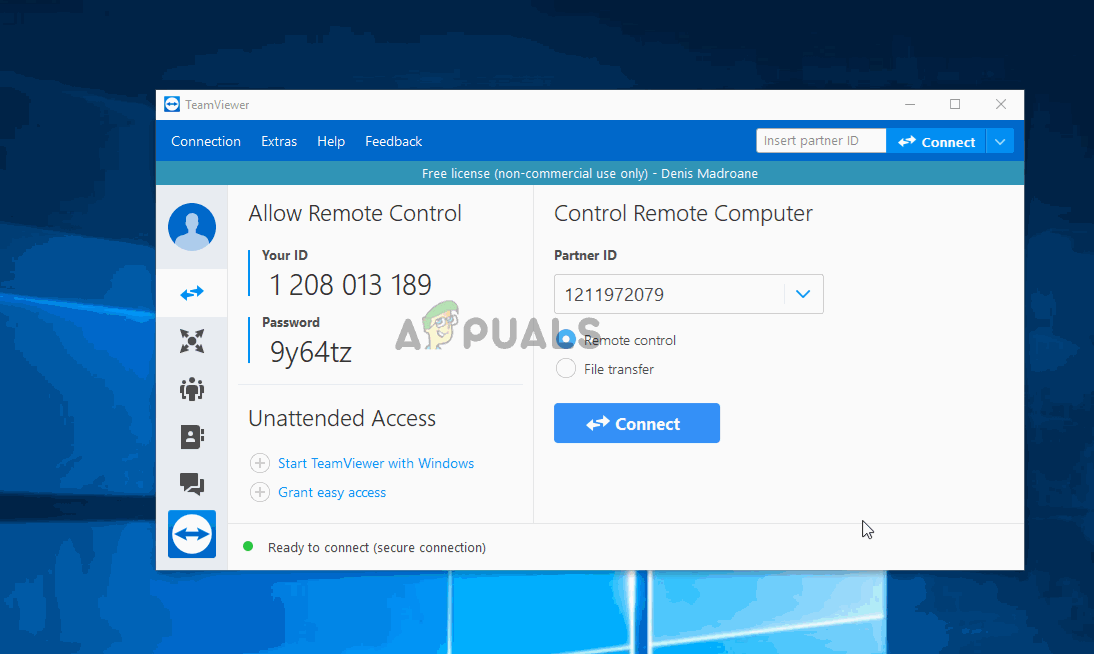
If you’re still encountering the “Initiating display parameters” error when trying to establish a connection between the to PCs, move down to the next method below.
Method 3: Reinstalling Teamviewer with Unattended Remote Access
One other possible reason why TeamViewer remains stuck with the “Initiating display parameters” error is that the client is only configured to allow connections when someone is logged in. If this scenario is applicable, you will be able to fix it by uninstalling TeamViewer and deleting one particular Registry Key. Then, after reinstalling the latest version of Teamviewer with Unattended Remote access, you should no longer encounter this particular issue.
Here’s a quick guide on how to do this:
- Press Windows key + R to open up a Run dialog box. Then, type “appwiz.cpl” and press Enter to open up Programs and Features.

Type appwiz.cpl and Press Enter to Open Installed Programs List - Inside the Programs and Features screen, scroll down through the list of applications and locate the TeamViewer version that you have installed. Once you see it, right-click on it and choose Uninstall to remove it from your system.
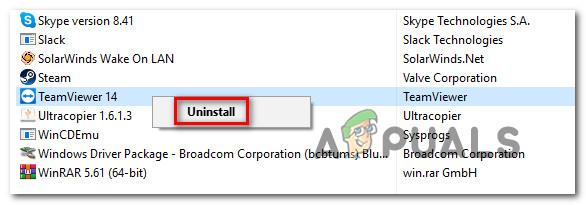
Uninstalling the current version of TeamViewer - With Teamviewer removed, you can close the Programs and Features window.
- Press Windows key + R to open up another Run dialog box. Then, type “regedit” and press Enter to open up the Registry Editor. When prompted by the UAC (User Account Control), click Yes to grant administrative privileges.
- Inside the Registry Editor, use the left panel to navigate to the following location:
HKEY_Local_Machine > Software > Wow6432Node > TeamViewer
- Once you see the TeamViewer registry key, right-click on it and choose Delete to remove it entirely.
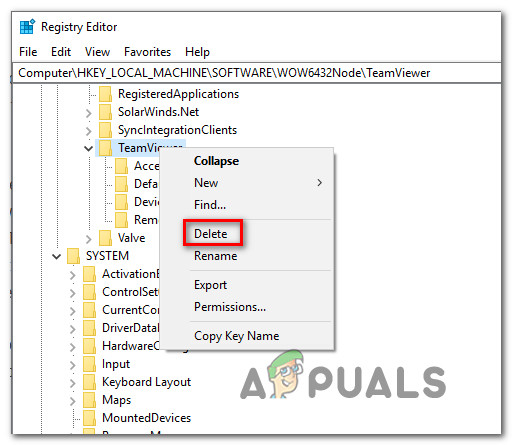
Deleting the TeamViewer Registry key - With the TeamViewer key deleted, restart your computer.
- At the next startup, Open TeamViewer and go to Connection > Open Management Console.
- If you don’t already have an account, click on Sign Up and complete the registration process. Else, simply input your login credentials and click on Sign In.
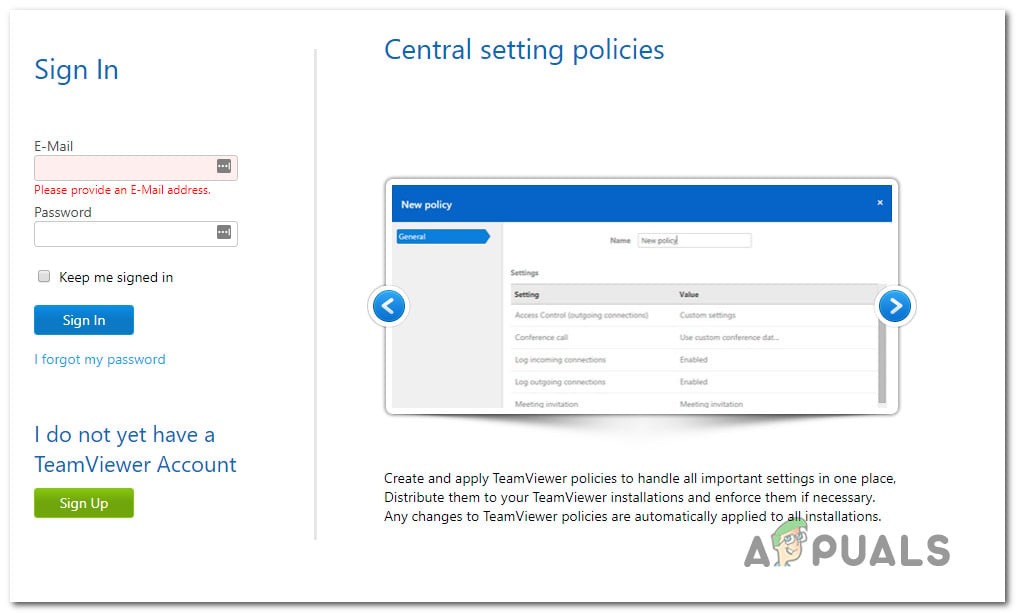
TeamViewer Management Console - Once you’re inside the TeamViewer Management Console, click on Add > Add computer (top-right corner). Then, make sure that the Add new device tag is selected, select Default TeamViewer from the drop-down menu and click on Download now.
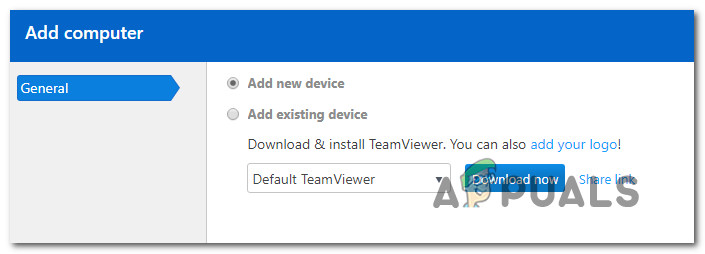
Downloading the Unattended Remote Access of TeamViewer Note: This step should be done from the host PC. The one that you connect remotely too.
- Follow the on-screen prompts to complete the installation.
- Move over to the computer that you use to connect remotely and see if you are able to establish the connection without encountering the “Initiating display parameters” error.
If you’re still encountering the same error message, move down to the next method below.
Method 4: Making sure that the computer is configured for remote control
Some users have been able to resolve the issue after discovering that their computer was not configured to allow a remote connection. After configuring their Windows version to allow remote connections, they reported that the “Initiating display parameters” error is no longer occurring.
Here’s a quick guide on how to ensure that Remote Control is enabled on your machine:
- Press Windows key + R to open up a Run dialog box. Then, type “sysdm.cpl” and press Enter to open up the System Properties screen.
- Once you’re inside the System Properties screen, click the Remote tab and make sure that the checkbox associated with Allow Remote Assistance connections to this computer is checked.
- Next, click the Advanced button below and make sure that the box under Remote control (Allow this computer to be controlled remotely) is checked.
- Click Apply, then restart your computer to enforce the changes.
- Attempt to initiate the connection again and see if you’re still encountering the “Initiating display parameters” error.

If the same error message is still occurring, move down to the next method below.
Method 5: Disabling conflicting process
As it turns out, this particular issue can also be caused by a case of conflicting processes. While there might be other conflicting processes, BGInfo (belonging to SysInternals is known to trigger the “Initiating Display Parameters” error if a connection is initiated with TeamViewer while the process is active.
This is mostly reported to occur if the BGInfo process is tasked with updating a dynamic wallpaper each time the user logs in. Because TeamViewer will also attempt to modify the settings as well, a conflict will be created in which the remote access application will hang.
If this particular case is applicable, the only viable fix that is known to resolve the issue is to disable the BGInfo process.
To do this, press Ctrl + Shift + Esc to open up Task Manager. Once you’re inside Task Manager, go to the Processes tab, right-click on the BGInfo process and choose End Task.

With the process ended, reinitiate the TeamViewer connection and see if you’re still encountering the same error message. If you’re still encountering the same error message, move down to the next method below.
Method 6: Disabling Standby mode from Power Settings
Another possible reason why you’re seeing the “Initiating Display Parameters” error when trying to initiate a TeamViewer connection between two computers is that the application is unable to wake the host system from standby mode.
This is a long-standing issue with TeamViewer, as we were able to discover plenty of user reports where the remote service is unable to initialize the display in instances where the host system is in standby.
If this scenario is applicable, you will be able to resolve the issue by ensuring that you keep the host system awake at all times by preventing it to enter in standby mode (so the display never gets turned off).
Here’s a quick guide on how to do this:
- Press Windows key + R to open up a Run dialog box. Then, type “powercfg.cpl” and press Enter to open up the Power Options screen.
- Inside the Power Options screen, observe your active Power Plan and click the Change plan settings button associated with it.
- From the Edit Plan Settings screen, change the drop-down menus (for Turn Off the display and Put the computer to sleep) to Never. Do this for both On battery and Plugged In.
- Once the changes have been operated, click on Save changes, then restart your computer.
- At the next startup, attempt to initiate the TeamViewer connection again and see if you’re still seeing the “Initiating Display Parameters”

If this method wasn’t applicable or you’re still encountering the “Initiating Display Parameters” error, move down to the next method below.
Method 7: Connecting via Server ID
There is one workaround that a lot of users encountering the “Initiating Display Parameters” error during a connection attempt have successfully used to avoid the issue. It involves using the TeamViewer server ID (instead of the TeamViewer user ID) to connect remotely.
This workaround is extremely simple as long as you know where to find the server ID. Here’s a quick guide on connecting via the Server ID:
- From the host machine, open TeamViewer and go to the Help tab using the ribbon at the top. Then, click on About TeamViewer.
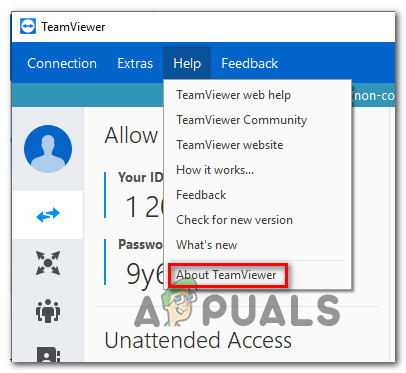
Accessing the About TeamViewer menu - Inside the newly opened About TeamViewer menu, copy the TeamViewer server ID and send it over to the person operating the machine that is trying to connect remotely.
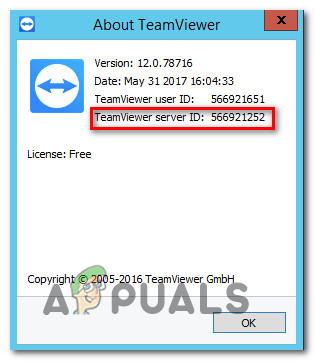
Discovering the Server ID - On the machine that is attempting to connect remotely, instead of using the default User ID, use the Server ID that you previously fetched at step 2.
You should now be able to connect successfully without encountering the “Initiating Display Parameters” error.





